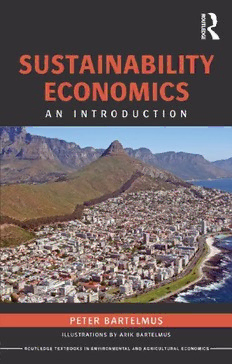
Sustainability Economics: An Introduction PDF
Preview Sustainability Economics: An Introduction
Sustainability Economics This book is a concise introduction to an emerging field within economics. Drawing on numerous disciplines, including environmental science, environ- mental and ecological economics and optimal growth theory, sustainability remains a hazy and complex subject. The author set out with two objectives: one, to bring some order into the proliferating measures, models and management of sustainability; and two, to facilitate access to a complex inter-disciplinary subject area. The book points to practical ways of assessing and enhancing the long-term environmental and economic sustainability of our economies. The result is a fully international study that should bridge the gap between disciplines and prove to be an essential guide to anyone interested in one of the most important concepts in the social sciences. Peter Bartelmus is a Professor at the University of Wuppertal, Germany. He wrote the book as a Visiting Scholar at Columbia University, USA. Routledge Textbooks in Environmental and Agricultural Economics 1 The Economics of Agricultural Development, Second Edition George W. Norton, Jeffrey Alwang and William A. Masters 2 A gricultural Marketing James Vercammen 3 Forestry Economics John E. Wagner 4 Agribusiness Management, Fourth Edition Jay Akridge, Freddie Barnard, Frank Dooley and John Foltz 5 Sustainability Economics An introduction Peter Bartelmus Sustainability Economics An introduction Peter Bartelmus with illustrations by Arik Bartelmus First published 2013 by Routledge 2 Park Square, Milton Park, Abingdon, Oxon OX14 4RN Simultaneously published in the USA and Canada by Routledge 711 Third Avenue, New York, NY 10017 Routledge is an imprint of the Taylor & Francis Group, an informa business © 2013 Peter Bartelmus The right of Peter Bartelmus to be identified as author of this work has been asserted by him in accordance with sections 77 and 78 of the Copyright, Designs and Patent Act 1988. All rights reserved. No part of this book may be reprinted or reproduced or utilized in any form or by any electronic, mechanical, or other means, now known or hereafter invented, including photocopying and recording, or in any information storage or retrieval system, without permission in writing from the publishers. Trademark notice: Product or corporate names may be trademarks or registered trademarks, and are used only for identification and explanation without intent to infringe. British Library Cataloguing in Publication Data A catalogue record for this book is available from the British Library Library of Congress Cataloging in Publication Data Bartelmus, Peter. Sustainability economics: an introduction/Peter Bartelmus. p. cm. 1. Environmental economics. 2. Sustainable development. 3. Economic development–Environmental aspects. I. Title. HC79.E5B368 2012 338.9’27–dc23 2011047099 ISBN: 978-0-415-68682-2 (hbk) ISBN: 978-0-415-68683-9 (pbk) ISBN: 978-0-203-11838-2 (ebk) Typeset in Times New Roman by Sunrise Setting Ltd To Little Lea, who will inherit what we leave behind Contents List of figures ix List of tables xi Preface xiii Acknowledgements xvii 1 Introduction 1 PART 1 Ecological sustainability: How much nature do we need? 11 2 How much nature do we have? 13 3 How much nature do we need? Can we sustain its use? 23 4 What should we do about it? 37 PART 2 Economic sustainability: How much for nature? 47 5 What is the value of nature? 49 6 Accounting for economic sustainability 61 7 What should we do about it? 73 8 Bridging the gap: ecological and environmental economics 86 viii Contents PART 3 Sustainable development: What else do we need? 95 9 A cure-all paradigm? 97 10 What should we do about it? 108 11 Some conclusions: What is countable? What counts? What should we do about it? 119 References 125 Author index 139 Subject index 143 Appendix 149 A syllabus for a short course, including powerpoint slides, can be accessed at the book’s web page at www.routledge.com Figures 1.1 Anthropocentric and eco-centric view of the human environment 2 1.2 Economic exchange system 3 1.3 Environment–economy interaction 3 1.4 Finding the balance (cid:79)5 1.5 Environmental-economic polarization 7 2.1 Global warming 16 2.2 Ecological Footprint 2007, major world regions 17 2.3 Material flow accounts of the European Union 19 2.4 Global energy balance 20 3.1 How bad is it? 24 3.2 Carrying capacity of people and their activities 25 3.3 Substitution 27 3.4 Economic growth and resource productivity in Germany: an input–outout model 29 3.5 Limits-to-growth model, business-as-usual scenario 30 3.6 Ecological Footprint trend 31 4.1 Delinking natural resource use from economic growth – a tunnel vision? 39 4.2 μηδέν ’άγαν, nothing in excess 41 4.3 Corporate social responsibility 42 4.4 Command and control 43 5.1 The value of nature 50 5.2 Environmental externality 51 5.3 How much for an elephant? 53 5.4 The total economic value 54 5.5 Discounting the damage of a nuclear meltdown 55 5.6 How much for nature? How much for economic output? 57 5.7 Economic values of an environmental service 59 6.1 GPI, GDP and personal consumption per capita, USA, 1950–2004 62
